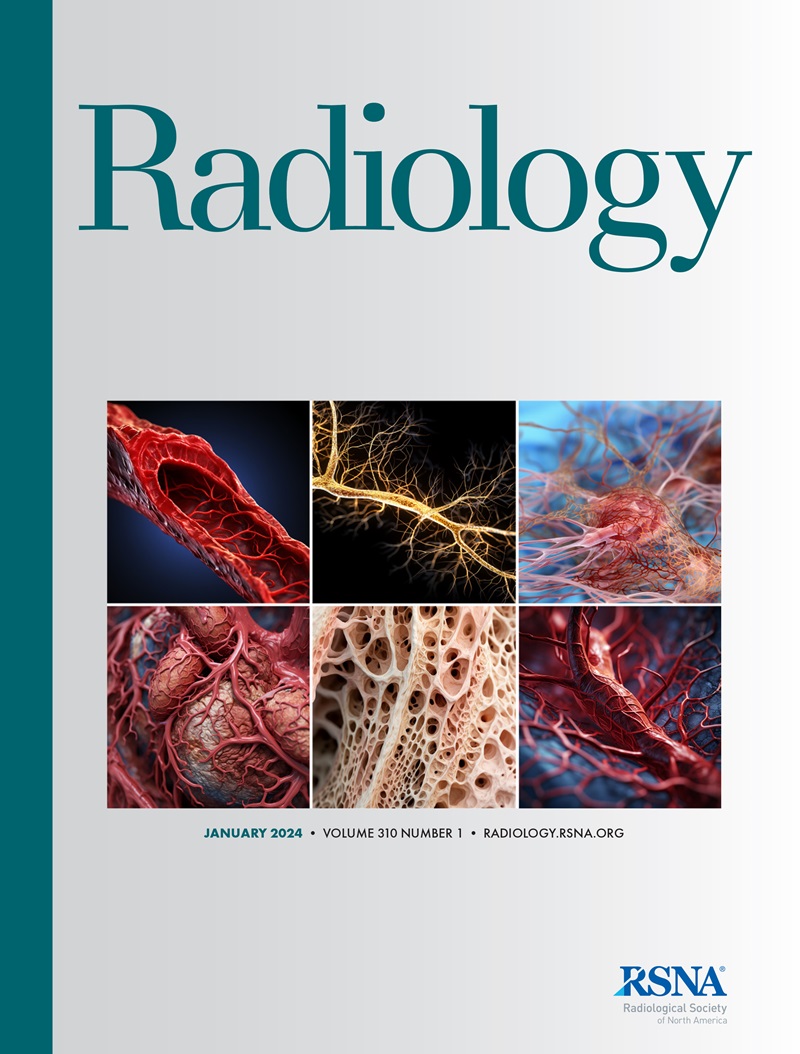下载PDF
{"title":"Risk of Malignancy in Cystic Lung Lesions in a Lung Cancer CT Screening Program.","authors":"Suzanne C Byrne, Andetta R Hunsaker, Mark M Hammer","doi":"10.1148/radiol.243166","DOIUrl":null,"url":null,"abstract":"<p><p>Background There is currently a lack of consensus regarding the risk of malignancy and the natural history of cystic lung lesions. Purpose To evaluate imaging characteristics associated with the risk of malignancy of cystic lung lesions in a lung cancer screening program. Materials and Methods This retrospective study included all CT lung cancer screening examinations performed from January 2015 to July 2023 in a large health care network. Radiology reports were queried for cystic lesions. Baseline CT images were reviewed, and lesion morphologic characteristics and size were recorded. All follow-up CT scans were evaluated for changes in the lesion. The risk of growth and diagnosis of cancer over time were analyzed with Kaplan-Meier curves. Results Among 15 762 patients, 235 were found to have cystic lung lesions; 33 (14%) of these patients were diagnosed with lung cancer arising from the cystic lesion. Increased risk of cancer was associated with nodular wall thickening (odds ratio [OR], 11; <i>P</i> = .002) and presence of a solid nodule (OR, 5.3; <i>P</i> < .001) alone or in combination with a ground-glass component (OR, 24; <i>P</i> < .001). Multilocularity was not associated with an increased risk of cancer (OR, 1.7; <i>P</i> > .2). There were no cases of malignancy in unilocular cystic lesions without wall thickening (<i>n</i> = 46). Lesion growth or increase in complexity over time was associated with an increased risk of malignancy (<i>P</i> < .001). The median time to lesion growth was 636 days. The median time to cancer diagnosis was 482 days, and 28 (85%) of the cancers were stage 0 or I. Conclusion Cystic lung lesions with nodular wall thickening had an increased risk of malignancy. Conversely, unilocular lesions without wall thickening had essentially no risk of malignancy. Most malignant cystic lung lesions exhibited indolent behavior, with slow growth and diagnosis at early stages. © RSNA, 2025 <i>Supplemental material is available for this article.</i> See also the editorial by Zagurovskaya in this issue.</p>","PeriodicalId":20896,"journal":{"name":"Radiology","volume":"315 2","pages":"e243166"},"PeriodicalIF":12.1000,"publicationDate":"2025-05-01","publicationTypes":"Journal Article","fieldsOfStudy":null,"isOpenAccess":false,"openAccessPdf":"https://www.ncbi.nlm.nih.gov/pmc/articles/PMC12127957/pdf/","citationCount":"0","resultStr":null,"platform":"Semanticscholar","paperid":null,"PeriodicalName":"Radiology","FirstCategoryId":"3","ListUrlMain":"https://doi.org/10.1148/radiol.243166","RegionNum":1,"RegionCategory":"医学","ArticlePicture":[],"TitleCN":null,"AbstractTextCN":null,"PMCID":null,"EPubDate":"","PubModel":"","JCR":"Q1","JCRName":"RADIOLOGY, NUCLEAR MEDICINE & MEDICAL IMAGING","Score":null,"Total":0}
引用次数: 0
引用
批量引用
Abstract
Background There is currently a lack of consensus regarding the risk of malignancy and the natural history of cystic lung lesions. Purpose To evaluate imaging characteristics associated with the risk of malignancy of cystic lung lesions in a lung cancer screening program. Materials and Methods This retrospective study included all CT lung cancer screening examinations performed from January 2015 to July 2023 in a large health care network. Radiology reports were queried for cystic lesions. Baseline CT images were reviewed, and lesion morphologic characteristics and size were recorded. All follow-up CT scans were evaluated for changes in the lesion. The risk of growth and diagnosis of cancer over time were analyzed with Kaplan-Meier curves. Results Among 15 762 patients, 235 were found to have cystic lung lesions; 33 (14%) of these patients were diagnosed with lung cancer arising from the cystic lesion. Increased risk of cancer was associated with nodular wall thickening (odds ratio [OR], 11; P = .002) and presence of a solid nodule (OR, 5.3; P < .001) alone or in combination with a ground-glass component (OR, 24; P < .001). Multilocularity was not associated with an increased risk of cancer (OR, 1.7; P > .2). There were no cases of malignancy in unilocular cystic lesions without wall thickening (n = 46). Lesion growth or increase in complexity over time was associated with an increased risk of malignancy (P < .001). The median time to lesion growth was 636 days. The median time to cancer diagnosis was 482 days, and 28 (85%) of the cancers were stage 0 or I. Conclusion Cystic lung lesions with nodular wall thickening had an increased risk of malignancy. Conversely, unilocular lesions without wall thickening had essentially no risk of malignancy. Most malignant cystic lung lesions exhibited indolent behavior, with slow growth and diagnosis at early stages. © RSNA, 2025 Supplemental material is available for this article. See also the editorial by Zagurovskaya in this issue.
肺癌CT筛查项目中囊性肺病变的恶性风险。
目前,关于恶性肿瘤的风险和囊性肺病变的自然史缺乏共识。目的评价肺癌筛查项目中囊性肺病变的影像学特征与恶性肿瘤风险的关系。材料与方法本回顾性研究纳入2015年1月至2023年7月在大型医疗保健网络中进行的所有CT肺癌筛查检查。询问影像学报告是否有囊性病变。回顾基线CT图像,记录病变的形态特征和大小。所有随访CT扫描评估病变的变化。用Kaplan-Meier曲线分析肿瘤生长和诊断的风险。结果15 762例患者中,发现肺囊性病变235例;其中33例(14%)被诊断为由囊性病变引起的肺癌。肿瘤风险增加与结节壁增厚相关(优势比[OR], 11;P = .002)和存在实性结节(OR, 5.3;P < .001)单独使用或与磨砂玻璃组分联合使用(or, 24;P < 0.001)。多房性与癌症风险增加无关(OR, 1.7;P > .2)。无壁增厚的单眼囊性病变无恶性肿瘤(n = 46)。随着时间的推移,病变的增长或复杂性的增加与恶性肿瘤的风险增加相关(P < 0.001)。到病变生长的中位时间为636天。诊断为肿瘤的中位时间为482天,28例(85%)为0期或1期。结论囊性肺病变伴结节性肺壁增厚,恶性肿瘤风险增高。相反,没有壁增厚的单眼病变基本上没有恶性风险。大多数恶性囊性肺病变表现为惰性行为,生长缓慢,早期诊断。©RSNA, 2025本文可获得补充材料。参见Zagurovskaya在本期的社论。
本文章由计算机程序翻译,如有差异,请以英文原文为准。

 求助内容:
求助内容: 应助结果提醒方式:
应助结果提醒方式:


